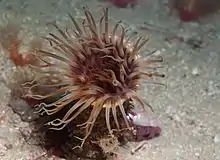Burrowing anemone
The burrowing anemone (Ceriantheopsis austroafricanus) is a species of tube-dwelling anemone in the family Cerianthidae.[1]
| Burrowing anemone | |
|---|---|
 | |
| Scientific classification | |
| Domain: | Eukaryota |
| Kingdom: | Animalia |
| Phylum: | Cnidaria |
| Subclass: | Ceriantharia |
| Order: | Spirularia |
| Family: | Cerianthidae |
| Genus: | Ceriantheopsis |
| Species: | C. austroafricanus |
| Binomial name | |
| Ceriantheopsis austroafricanus Molodtsova, Griffiths & Acuna, 2012 | |
Description
The burrowing anemone grows up to 8 cm in diameter. It lives in a self-constructed wrinkled felt-like tube which may be buried quite deeply in the sand. Several rows of feeding tentacles emerge from the tube and may be salmon-coloured, brownish, creamy or purple. The outer tentacles are longer and used for food capture and defence. The inner tentacles are shorter and held more erect. These are used for food manipulation and ingestion.[2]
Distribution
The burrowing anemone has been found in Table Bay and False Bay around the Cape Peninsula and Hermanus on the south coast of South Africa, and lives from the subtidal zone down to at least 25m under water.
Ecology
This anemone is found in sandy and silty areas.[2]
References
- Molodtsova T. N., Griffiths C. L., Acuna F.H. 2011. A new species of shallow-water cerianthid (Cnidaria: Anthozoa) from the South Africa, with remarks on the genus Ceriantheopsis. Afr. Nat. Hist. 7: 1-8.
- Jones, Georgina. A field guide to the marine animals of the Cape Peninsula. SURG, Cape Town, 2008. ISBN 978-0-620-41639-9